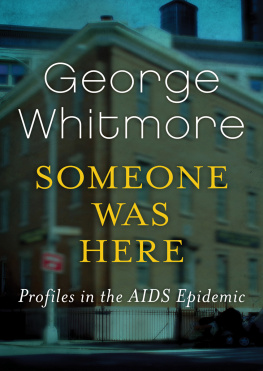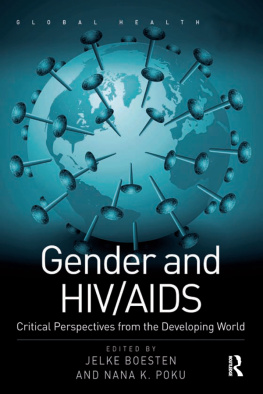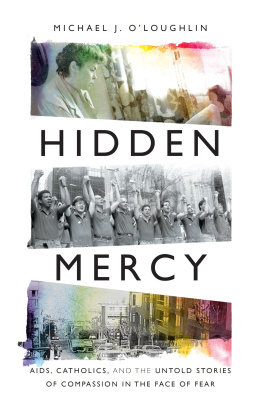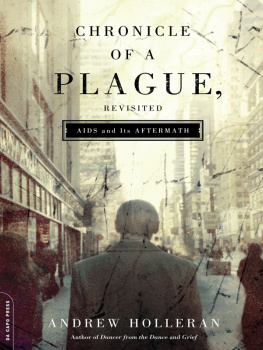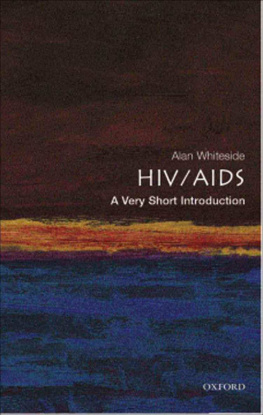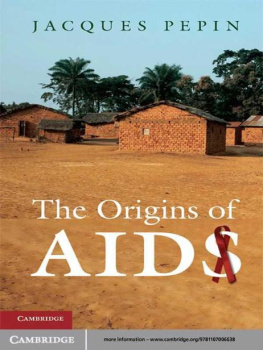Someone Was Here
Profiles in the AIDS Epidemic
George Whitmore

For Michael, who endured
AUTHORS NOTE
ATTEMPTING TO DEFINE THE galvanizing phenomenonpolitical, social, medicalof AIDS in America is somewhat like the parable about the three blind men and the elephant: one holds in his hand a rope, another works his way along a wall, the third wrestles with a boa constrictor. AIDS is a mirror, reflecting every individuals deepest fears. AIDS is a magnet, indiscriminately attracting all manner of prejudices. AIDS is a juggernaut cutting a wide swath across the nation. This book can only provide a partial view of a few aspects of it. I would have liked to have provided a panorama. But AIDS is moving too fast for that, so Ive had to settle for something more like snapshots taken from a speeding train. Consider: this book covers three years in the epidemic. In February 1985, when the book begins, there were 8,495 diagnosed cases of AIDS nationwide. In February 1987, when it ends, there were 31,036.
This book consists primarily of interviews with people who told their stories to me in an effort to further understanding about AIDS and the human tragedy it is. Notwithstanding the potent stigma attached to AIDS, without exception the protagonists of this book insisted on using their real names. In order to protect confidentiality, however, names of patients at Lincoln Hospital have been changed and certain identifying characteristics have been altered. In a few other instances where participants requested that only first names or pseudonyms be used, its indicated in the text.
Although, obviously, Ive dramatized events in this book, it is factual. Conversations and incidents I didnt witness were reconstructed. Some were telescoped and/or streamlined to provide a coherent narrative. Many are based on hearsaythat is, the unconfirmed recollection of a single participant.
PROLOGUE
THERES A PICTURE I keep in front of me. I cut it out of a magazine. Its a photograph taken in a monastery on Mt. Athos, a peninsula in northern Greece. The monasteries at Mt. Athos were founded in Byzantine times and, as far as anyone knows, no woman has set foot on the peninsula since then. So if youre male, you can apply for permission to visit the monks on Mt. Athos, who otherwise live utterly isolated amidst amazing treasures just as they have for centuries.
This photo was taken in a charnel house and the first thing you see is skulls, a pile of them. Theyre stacked up neatly in rows, one on top of the other. Images of the Black Death come instantly to mind.
One skull is out of placemaybe someone was careless arranging the skulls or maybe the pile settled over the years, for one skull lies face up. Instead of eye-and nose-holes, you find yourself looking into the hole where the spine went ina round Oand the two hollows under the cheekbones. It makes this face look exclamatory.
The skulls sit in ranks on a ledge against a rough whitewashed wall. Some of them are almost as white as the wall. Others are parchment-colored. The pile of skulls is so graphic, at first you dont even notice the monk.
This monkrecedes into the background. Hes wearing black. The photographers flash casts the wall behind him into shadow. His black beard all but obscures a gaunt profile. Hes holding a big box full of bones.
The box is made of wood and has a hinged lid. There are two skulls and some arm or shin bones in the box. One of the skulls has letters written on it. Pieces of paper have been bound around a few of the bones with leather thongsthese arent just bones, theyre relics. The skulls on the ledge havent been labeled. They must have belonged to ordinary monks. I like to think those died peacefully of old age in their narrow beds.
The monk has turned his face away from the camera. Maybe he doesnt want to have his picture taken. Maybe he even considers it a sacrilege. It makes you wonder what the photographer had to do to get this picture. Who gave him permission? Did he even ask? He must have known a great picture when he saw one. Did he pose the monk against the skulls? Did he shoot a whole roll? Once youve taken the first picture, I know, its easy to snap a second and a third. People will stand for it.
The monk has averted his face. Maybe, secretly, he is bloated with pride because he is the one who was chosen to display the bones, but I dont knowit seems to be a gesture of humility. Blank as the wall, he seems to be saying, Im blank as the wall, stock-stone-still like the stone ledge holding the pile of skulls, holding out this box with the bones in it as proofsomeone was here.
But fleetingly, you thinkbecause you dontmaybe he just doesnt want to look into the box. Maybe he finds the bones disgusting.
Maybe not. Maybe he reveres them so, he has to avert his face, because theyre so holy.
You glance back at the bones in the box. The skulls on the ledge are as clean as cattle skulls picked clean, sun-bleached in the desert. The bones in the box look mottled, rotted. Maybe not. Maybe theyve been polished, varnished to a darker hue. One of the skulls has fallen forward and almost seems to be gnawing on the edge of the box.
Like the round O in the skull behind him, the black hole of the monks convoluted ear seems somehow articulate. His unseen eyes are eloquent. When I opened the magazine in a waiting room and saw this photo, I was sure this man was signaling, he could hardly bear to show us what was in the box.
But someone, I thought, has to tend to the bones. Someone has to arrange and rearrange the display. Someone has to take the box down off the shelf to show you. This is that man.
1985
HAPPY ARE MEN WHO yet before they are killed
Can let their veins run cold.
Whom no compassion fleers
Or makes their feet
Sore on the alleys cobbled with their brothers.
Wilfred Owen
GREENWICH VILLAGE, NEW YORK CITY
A TANGLE OF STREETS, MANY of them still lined with low houses, this part of New York was once a true village, a remote suburb and resort from the plague that coursed through lower Manhattan in the early 19th century. Time was, dairy maids from New Jersey would row across the Hudson to sell their buttermilk in the Village, clam barges would tie up at the waterfront, and bloody beef would hang on hooks at the butchers along the length of Washington Street.
Skirting quaint old Greenwich Village, the gridded city marched uptown. Because it remained a backwater and a low-rent refuge, the Village attracted artists and thinkers. By the 1920s, it had became internationally known as the cradle of American Bohemianism, teeming with nonconformists, a hotbed of free love. Art, politics, and passion were inseparable from the romance of the Village, with its smoke-filled cafes, cobbled lanes, and unmade beds.
Not quite as notorious as the bottle parties and Bolshevik coffeehouses, one aspect of Village life was nevertheless apparent to anyone who walked its streets open eyed: a certain kind of man and a certain kind of woman had staked a claim on the Village. In the popular mind,

